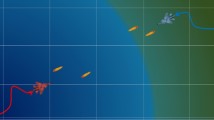Abstract
In order to improve the intelligent perception and adaptability of the 6G network, drones joined this challenge. For large-scale long-range Unmanned Aerial Vehicle (UAV), most of the time during normal flight belongs to fixed altitude flight. It is required to sail along the planned optimal path. Whether it can fly along the optimal path is mainly attributed to the tracking problem of horizontal flight trajectory. In order to minimize the UAV horizontal plane tracking error, it is necessary to consider the influence of many factors (such as strong winds, heavy rain, obstacles, etc.). Due to the complexity of High-Altitude environment, these disturbances are uncertain. In addition, there are some dynamic errors in the model of UAV control system, and these errors also have uncertainties. And, due to the change of global planning path coordinates, the control system needs to adjust the set value in real time during AUV horizontal trajectory tracking, and the conventional control algorithm is difficult to meet the requirements. Therefore, firstly, the influence of prediction uncertainty of grey prediction on AUV horizontal track tracking control is used; Then the grey prediction is improved according to the practical application; Ultimately, the control law is designed by combining the grey prediction with the control method. Finally, the grey prediction fuzzy adaptive PID method of UAV flight control is applied to the planned path simulation, and good control results are obtained.












Similar content being viewed by others
Data availability
The datasets used and/or analyzed during the current study are available from the corresponding author on reasonable request.
References
He Zhenqi; Yao Lu.(2021) .Research on an Obstacle Avoidance Method for UAV. Mathematical Problems in Engineering. 2021.
Jian, D., & Bin, He. (2018). Novel fuzzy PID-type iterative learning control for quadrotor UAV. SENSORS, 19(1), 24.
Wai, R.-J., & Prasetia, A. S. (2019). Adaptive neural network control and optimal path planning of UAV surveillance system with energy consumption prediction. IEEE ACCESS., 7, 126137–126153.
Lindqvist, B., Mansouri, S. S., Agha-Mohammadi, A.-A., & Nikolakopoulos, G. (2020). Nonlinear MPC for collision avoidance and control of UAVs with dynamic obstacles. IEEE Robotics and Automation Letters, 5(4), 6001–6008.
Mendoza, A.-R., & Yu, W. (2023). Fuzzy adaptive control law for trajectory tracking based on a fuzzy adaptive neural PID controller of a multi-rotor unmanned aerial vehicle. International Journal of Control, Automation and Systems, 21(2), 658–670.
Hu, Y.-C. (2020). A multivariate grey prediction model with grey relational analysis for bankruptcy prediction problems. Soft Computing, 24(6), 4259–4268.
Wang, Y., Shi, Y., Cai, M., Xu, W., & Yu, Q. (2018). Optimization of air-fuel ratio control of fuel-powered UAV engine using adaptive fuzzy-PID. Journal of the Franklin Institute-Engineering and Applied Mathematics, 355(17), 8554–8575.
Basri, M. A. M., Husain, A. R., & Danapalasingam, K. A. (2015). A hybrid optimal backstepping and adaptive fuzzy control for autonomous quadrotor helicopter with time-varying disturbance. Proceedings of the Institution of Mechanical Engineers, 229, 2178–2195.
Ermeydan, A., & Kiyak, E. (2017). Fault tolerant control against actuator faults based on enhanced PID controller for a quadrotor. Aircraft Engineering and Aerospace Technology, 89(3), 468–476.
Tong, W., Zhao, T., Duan, Q., Zhang, H., & Mao, Y. (2022). Non-singleton interval type-2 fuzzy PID control for high precision electro-optical tracking system. ISA Transactions, 120, 258–270.
Sun, C., Liu, M., Liu, C., Feng, X., & Wu, H. (2021). An industrial quadrotor UAV control method based on fuzzy adaptive linear active disturbance rejection control. Electronics, 10(4), 376–398.
Acknowledgements
UAV intelligent control technology innovation team (Grant: KJTD20-002), School level scien-tific research projects(Grant: 21XHTD-03), Project of Shaanxi Vocational and technical education society in 2022 (Grant: 2022SZX096)
Author information
Authors and Affiliations
Corresponding author
Ethics declarations
Conflict of interest
The author(s) declared no potential conflicts of interest with respect to the research, author-ship, and/or publication of this article.
Additional information
Publisher's Note
Springer Nature remains neutral with regard to jurisdictional claims in published maps and institutional affiliations.
Rights and permissions
Springer Nature or its licensor (e.g. a society or other partner) holds exclusive rights to this article under a publishing agreement with the author(s) or other rightsholder(s); author self-archiving of the accepted manuscript version of this article is solely governed by the terms of such publishing agreement and applicable law.
About this article
Cite this article
He, Z. Research on UAV flight control and communication method based on fuzzy adaptive. Wireless Netw (2023). https://doi.org/10.1007/s11276-023-03408-3
Accepted:
Published:
DOI: https://doi.org/10.1007/s11276-023-03408-3




